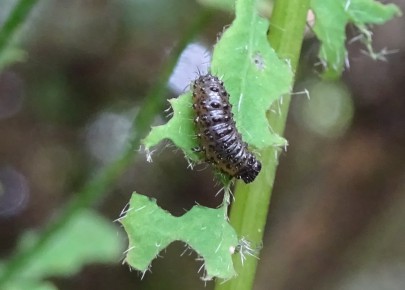Three for the Price of One in Chile

Chrysomelid larva feeding on Chilean flame creeper
Chilean flame creeper is a vigorous perennial vine with attractive, bright-red flowers and blue berries. It has been naturalised in New Zealand since the 1950s and is highly invasive in Southland, where it colonises forest margins and disturbed sites, smothering native vegetation. Although not as abundant in the north, its range extends up to Waikato, and there has been one report of the weed in Northland. Chilean flame creeper seeds are readily dispersed by birds, and the rootstock and stems easily re-sprout, making it difficult to control.
Research on Chilean flame creeper prior to the trip suggested that the plant is very rare in its native range, which could partly be attributed to the unusual geography and diverse climate of Chile, ranging from dry and arid in the north to cold and wet in the south. Chilean flame creeper has been recorded in the south of Chile, where it grows in humid areas along the coast up to 1,000 m above sea level. Chantal and Randall, along with our Chilean collaborator, Dr Hernán Norambuena (entomology consultant), searched for the creeper in the Bío Bío, Auracanía and Los Rios regions of Chile, where Hernán had already located two sites.
“When we first got out into the field, we soon realised that our surveys would be challenging, not only because of the rarity of the plant, but also because they were not in flower at the time,” explained Chantal. “This was further complicated by the fact that most of the herbarium records were old and outdated, so many of the sites had been replaced by Pinus and Eucalyptus plantations, or farmland, or they were no longer accessible to the public,” she added. Since the herbarium records indicated that Chilean flame creeper was often found in close association with native bamboo (Chusquea spp.), the group focused their search on bamboo stands growing in close proximity to waterways. “We spent hours staring at foliage surrounding bamboo in the hope that we would spot a new plant which would provide us with another survey site,” said Chantal. “Not even the locals seemed to have encountered this climber with its bright red flowers!”
Fortunately their efforts were not in vain, and they managed to find another two sites to add to the list. Of the four sites that were surveyed, three were along roadsides and one was in a hazelnut orchard. At all three roadside sites black insect larvae were found actively feeding on the leaves of Chilean flame creeper and were very damaging. A subsequent DNA analysis revealed that the larvae belong to the leaf beetle family, Chrysomelidae, and they were later confirmed to be Blaptea elguetai. Not a lot is known about this beetle, but it is thought likely to be highly host specific “Interestingly, but not surprisingly, the orchard site did not show any signs of insect feeding damage, probably due to regular pesticide use in the orchard, and the plants were growing there vigorously as they do in Southland,” said Chantal.
Although there is much groundwork to be done before the beetles will be considered for importation into New Zealand, this was a very promising find. High numbers of Chrysomelid beetles have been successfully used as biocontrol agents worldwide, and they have an excellent track record for being highly host specific and very damaging to their hosts. Hernán, with the help of his wife Angelica and collaborator Sergio Escobar, have since located 24 additional Chilean flame creeper sites where they regularly found the chrysomelid larvae, as well as adult chrysomelid beetles of two different colours. Future work on Chilean flame creeper will be geared towards investigating their host range when funds permit.
As for the pathogens, Darwin’s barberry fruits infected with the rust and a pampas floral stem infected with the smut were successfully imported into our containment facility at Tamaki, Auckland, for host range testing and mating experiments, respectively. Not a bad haul for one trip to Chile!
This project was funded by the Department of Conservation, Waikato Regional Council, Horizons Regional Council, Greater Wellington, Environment Canterbury, Otago Regional Council and Environment Southland.

